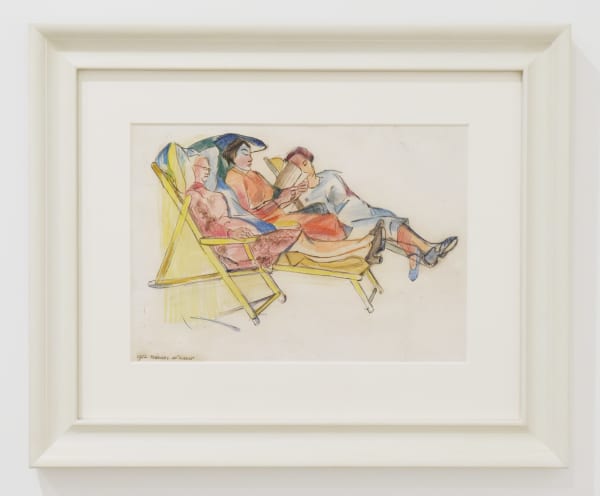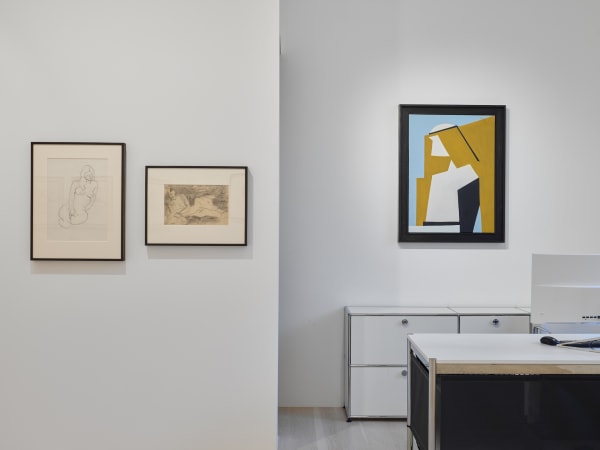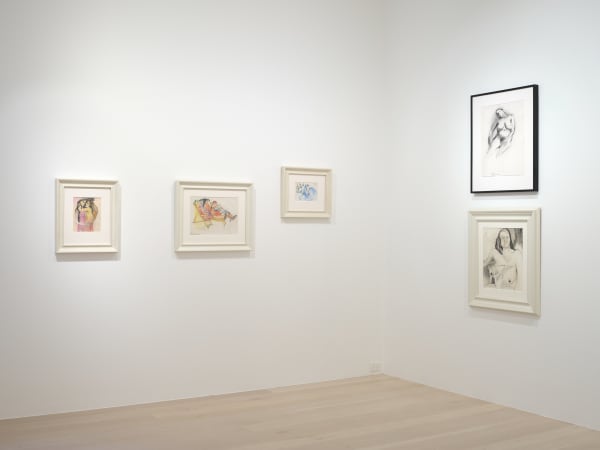Works on Paper: Dame Louise Henderson
The selection of works included in this exhibition showcase Henderson’s enticing vision and disciplined artistic practice.
Dame Louise Henderson is one of New Zealand’s most important modernist artists. Born in Paris in 1902, Henderson migrated to New Zealand in 1925, and soon after took up studying art at the University of Canterbury. She moved to Wellington in the 1940s, where she developed an interest in modernism. This interest was augmented by correspondence with the painter John Weeks, then a lecturer at Elam School of Fine Arts. From the late 1940s on, Henderson began to explore cubist approaches to image composition - a development that became central to her mid-career practice.
When Henderson returned to New Zealand after studying under Jean Metzinger in Paris in the early 1950s, her work was exhibited by Auckland City Art Gallery twice in quick succession. These exhibitions were met with considerable critical acclaim, though Henderson was soon to head abroad again. During the mid and late 1950s, she spent a sustained period in the Middle East, punctuated with trips to Europe to view art galleries and museums. This time was formative for the artist, and it involved the production of a substantial body of highly accomplished artwork.
The selection of works included in this exhibition showcase Henderson’s enticing vision and disciplined artistic practice through intimate pencil and charcoal drawings. Many of these pared back portraits and landscape scenes show Henderson’s strength in observational drawing and tell a story of her extensive years of travel.
-
![Dame Louise Henderson, Untitled [passionate couple]](data:image/gif;base64,R0lGODlhAQABAIAAAAAAAP///yH5BAEAAAAALAAAAAABAAEAAAIBRAA7) Dame Louise Henderson, Untitled [passionate couple]
Dame Louise Henderson, Untitled [passionate couple] -
![Dame Louise Henderson, Iraq [Arab Man], 1957](data:image/gif;base64,R0lGODlhAQABAIAAAAAAAP///yH5BAEAAAAALAAAAAABAAEAAAIBRAA7) Dame Louise Henderson, Iraq [Arab Man], 1957
Dame Louise Henderson, Iraq [Arab Man], 1957 -
![Dame Louise Henderson, Untitled [Persia], 1957](data:image/gif;base64,R0lGODlhAQABAIAAAAAAAP///yH5BAEAAAAALAAAAAABAAEAAAIBRAA7) Dame Louise Henderson, Untitled [Persia], 1957
Dame Louise Henderson, Untitled [Persia], 1957 -
![Dame Louise Henderson, Iraq [Arab Man], 1957](data:image/gif;base64,R0lGODlhAQABAIAAAAAAAP///yH5BAEAAAAALAAAAAABAAEAAAIBRAA7) Dame Louise Henderson, Iraq [Arab Man], 1957
Dame Louise Henderson, Iraq [Arab Man], 1957 -
 Dame Louise Henderson, February 'On Ruahine', 1952
Dame Louise Henderson, February 'On Ruahine', 1952 -
 Dame Louise Henderson, Nude Study, c. 1970
Dame Louise Henderson, Nude Study, c. 1970 -
 Dame Louise Henderson, The Cubist Construction of Nancy Cane
Dame Louise Henderson, The Cubist Construction of Nancy Cane -
 Dame Louise Henderson, Arab Portrait No.8, 1959
Dame Louise Henderson, Arab Portrait No.8, 1959 -
 Dame Louise Henderson, Untitled, 1985
Dame Louise Henderson, Untitled, 1985 -
 Dame Louise Henderson, Untitled
Dame Louise Henderson, Untitled -
 Dame Louise Henderson, Untitled
Dame Louise Henderson, Untitled -
![Dame Louise Henderson, Untitled [Pub Scene]](data:image/gif;base64,R0lGODlhAQABAIAAAAAAAP///yH5BAEAAAAALAAAAAABAAEAAAIBRAA7) Dame Louise Henderson, Untitled [Pub Scene]
Dame Louise Henderson, Untitled [Pub Scene]
Dame Louise Henderson is one of New Zealand’s most important modernist artists. Born in Paris in 1902, Henderson migrated to New Zealand in 1925, and soon after took up studying art at the University of Canterbury. She moved to Wellington in the 1940s, where she developed an interest in modernism. This interest was augmented by correspondence with the painter John Weeks, then a lecturer at Elam School of Fine Arts. From the late 1940s on, Henderson began to explore cubist approaches to image composition [1] – a development that became central to her mid-career practice.
In the 1950s Henderson’s work flourished. She moved with her family to Auckland in 1950 and took to painting full time. Encouraged by Weeks, she returned to Paris in 1952 for a year to study figurative cubism. [2] Of this time, notable New Zealand author C.K. Stead wrote, “Mrs. Henderson reappeared in Auckland to my knowledge in 1954. In the meantime she had gone to Paris, her birthplace, and studied under Jean Metzinger, one of the founders of the Cubist movement. His influence was plainly apparent in her new work. But if the style was Metzinger's, the sense of colour, and the intellect with which the Cubist discipline had been applied, were entirely Mrs. Henderson's own. […] I imagine Mrs. Henderson's ideal to be a painting in which colour and forms are hardly distinct, hardly separable - in which colours flow into one another suggesting at different moments and to different observers a variety of natural forms.” [3]
When Henderson returned to New Zealand after studying under Metzinger, her work was exhibited by Auckland City Art Gallery twice in quick succession. These exhibitions were met with considerable critical acclaim, though Henderson was soon to head abroad again. During the mid and late 1950s, she spent a sustained period in the Middle East, punctuated with trips to Europe to view art galleries and museums. This time was formative for the artist, and it involved the production of a substantial body of highly accomplished artwork.
The selection of works included in this exhibition showcase Henderson’s enticing vision and disciplined artistic practice. Her output from the 1950s is well represented, including during her time in the Middle East. On one level, the drawings titled Iraq [Arab Man] (two examples) and Bagdad, all which date from 1957,are pared back portraits that show the artist’s strength in observational drawing. On another level, these works demonstrate her ongoing experimentation with cubism. The works are intentionally flat, capturing the subjects with unadorned clarity. In themselves, these drawings do not break up the images into semi-abstract forms. Yet, they clearly informed subsequent paintings that do, such as the masterful Arab Portrait No. 8. In this work, the artist has created a highly stylised, flat-planed figure with a handful of crisp blocks of colour. This work is an excellent example of Henderson’s sophisticated painting practice, and it is among most accomplished from her time in the Middle East.
Henderson continued to develop her craft, creating a distinctive painting language. Works from the 1970s and 80s included in this exhibition demonstrate the continuous development of her work, and the ongoing importance of drawing. Her later work featured bold colours and intertwined planes, an approach she took in both her abstract and figurative paintings. This style can be seen in the untitled work from 1985 – the sole entirely abstract work in this selection. A bright palette and a cluster of interlinked shapes give this work a dynamic sense of energy. This vibrant sensibility was a feature of Henderson’s later paintings, which she continued to produce up until the final stages of her life.
This selection of works shines a light on the trajectory and formative process of an artist who would go on to become one of the most important modernists in New Zealand art history. In particular, it provides rich insight into Henderson’s life-long engagement with drawing, a vitally important component of her artistic practice.
[1] Elizabeth M. Grierson. 'Henderson, Louise Etiennette Sidonie', Dictionary of New Zealand Biography, first published in 2000. Te Ara - the Encyclopedia of New Zealand, https://teara.govt.nz/en/biographies/5h16/henderson-louise-etiennette-sidonie (accessed 12 June 2023).
[2] Ibid.
[3] C.K. Stead, “The Development of Louise Henderson’s Vision: A Personal Note.” Artis 1, no.3 (1971): 25-27.
![Dame Louise Henderson Untitled [passionate couple] colour pencil on cardboard 277 x 260mm 560 x 485 x 45mm framed](https://artlogic-res.cloudinary.com/w_800,h_800,c_limit,f_auto,fl_lossy,q_auto/artlogicstorage/gowlangsford/images/view/e6b3eb9a641cd16fd391134eff0a4488j/gowlangsford-dame-louise-henderson-untitled-passionate-couple.jpg)
![Dame Louise Henderson, Untitled [passionate couple]](https://artlogic-res.cloudinary.com/w_600,c_limit,f_auto,fl_lossy,q_auto/artlogicstorage/gowlangsford/images/view/e6b3eb9a641cd16fd391134eff0a4488j/gowlangsford-dame-louise-henderson-untitled-passionate-couple.jpg)
![Dame Louise Henderson, Iraq [Arab Man], 1957](https://artlogic-res.cloudinary.com/w_600,c_limit,f_auto,fl_lossy,q_auto/artlogicstorage/gowlangsford/images/view/de42e64aa36f2ccf3621414baf2712a3j/gowlangsford-dame-louise-henderson-iraq-arab-man-1957.jpg)
![Dame Louise Henderson, Untitled [Persia], 1957](https://artlogic-res.cloudinary.com/w_600,c_limit,f_auto,fl_lossy,q_auto/artlogicstorage/gowlangsford/images/view/d161e035822dae9bfad5e1c1e3900456j/gowlangsford-dame-louise-henderson-untitled-persia-1957.jpg)
![Dame Louise Henderson, Iraq [Arab Man], 1957](https://artlogic-res.cloudinary.com/w_600,c_limit,f_auto,fl_lossy,q_auto/artlogicstorage/gowlangsford/images/view/d1eed74714f1c35f9889ae6c36898185j/gowlangsford-dame-louise-henderson-iraq-arab-man-1957.jpg)







![Dame Louise Henderson, Untitled [Pub Scene]](https://artlogic-res.cloudinary.com/w_600,c_limit,f_auto,fl_lossy,q_auto/artlogicstorage/gowlangsford/images/view/4d65783ba9f7d4724412736f95de1015j/gowlangsford-dame-louise-henderson-untitled-pub-scene.jpg)







